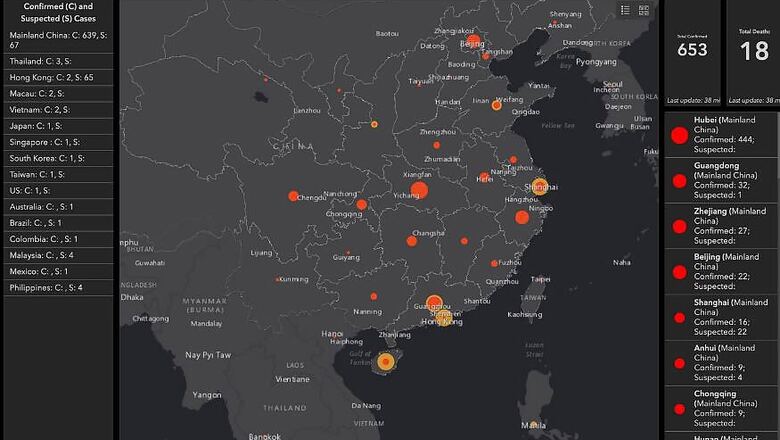
views
As authorities and public health experts globally are attempting to understand and eventually contain the as yet unidentified Coronavirus which first emerged in Wuhan, China, there are fears that it could spread around the world as millions of people travel. This comes as the Chinese authorities have confirmed that the death toll from the Wuhan Coronavirus is now 25 with as many as 830 further confirmed cases. Researchers in the US have made a new real-time map that tracks the global spread of the Coronavirus—you can access it here.
This map has been developed by the Center for Systems Science and Engineering at the John Hopkins University in Baltimore. This map relies on data collected from the World Health Organization (WHO), Centers for Disease Control and Prevention (CDC), National Health Commission of the People's Republic of China (NHC) and Dingxiangyuan, which is an online medical community. This live map may be great news for travellers who could find this as a good reference point to check if they must go ahead with their journey or not.
Scientists believe that the Coronavirus, the 2019-nCoV as it is being called, enters the human body through the nose or mouth. It then finds a host cell in the respiratory system. After some incubation period, the host cell disintegrates thereby spreading the virus to the nearby cells, thereby multiplying the infection inside the human body.
The Coronavirus is already a global problem. It is believed that travellers from Wuhan, China were responsible for the spread of the Coronavirus to other countries, not that they would have known because symptoms usually do not show up for days after the virus enters the human body. The CSSE documents that on Jan 13, Thailand reported the first international case outside China, while the first cases within China, but outside of Wuhan were reported on January 19—these were in Guangdong and Beijing. China’s National Health Commission (NHC) confirmed on January 20 that the coronavirus can be transmitted between humans, since the virus can be put back into the surroundings by a simple sneeze or cough. Data also suggests that the human infections with 2019-nCoV were also confirmed in Japan and South Kore on January 20. On January 21, cases in the U.S. and Taiwan were detected in travellers coming from Wuhan. Travelers infected with the 2019-nCoV have also been detected in Hong Kong, Macau, Singapore and Vietnam.
The WHO emergency committee convened to discuss whether the outbreak should be classified as a global public health emergency, but has decided that it is still too early to declare this a global epidemic or pandemic. Chinese authorities say that among the 830 confirmed cases, 177 are in a serious condition and 34 have been cured and discharged. The symptoms of the 2019-nCoV include runny nose, cough, sore throat and high temperature. It can also lead to pneumonia, an infection where the lungs fill up with fluid and can lead to death by ‘drowning’.
“Early on, many of the patients in the outbreak in Wuhan, China reportedly had some link to a large seafood and animal market, suggesting animal-to-person spread. However, a growing number of patients reportedly have not had exposure to animal markets, suggesting person-to-person spread is occurring. At this time, it’s unclear how easily or sustainably this virus is spreading between people,” says the CDC. Coronaviruses are common in many animals, and have also evolved forms that can infect humans too—two recent coronaviruses evolutions have resulted in the SARS outbreak in 2002 and the MERS outbreak in 2012.
The Pharmaceutical Technology reports that scientists at the National Institutes of Health (NIH) in the US are already working on a vaccine against the deadly coronavirus, but it could be almost an year before it becomes available. They are using the data from their understanding of the Severe Acute Respiratory Syndrome (SARS) virus for this vaccine. But clearly, this won’t come in time to help anyone unfortunately infected by the 2019-nCoV. SARS had infected more than 8000 people in Asia and killed more than 800 at the time.
















Comments
0 comment